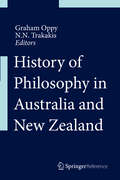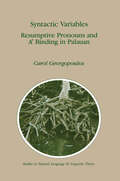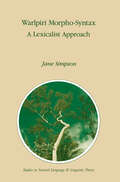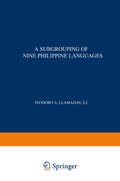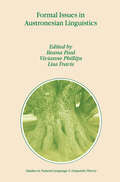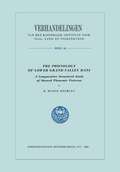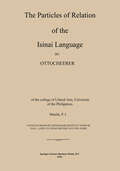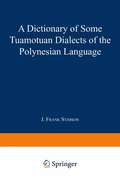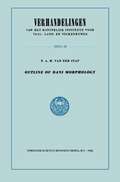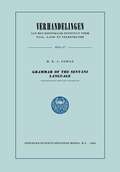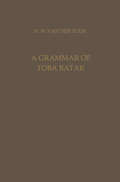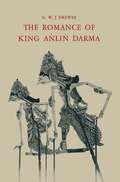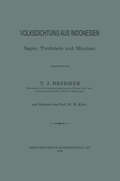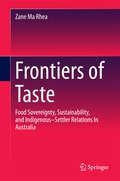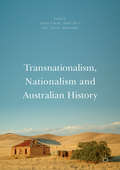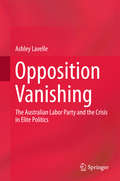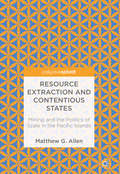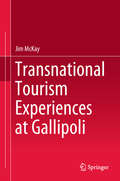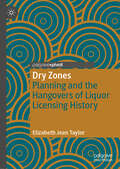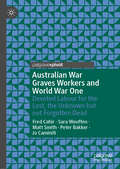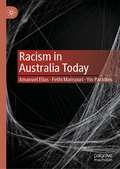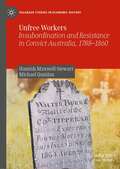- Table View
- List View
Syntactic Variables: Resumptive Pronouns and A′ Binding in Palauan (Studies in Natural Language and Linguistic Theory #24)
by C. GeorgopoulosThis book represents the culmination of an extended period of field work on the Palauan language, carried out while I was a graduate student at the University of California at San Diego. The book was born as a short term paper written in 1982; from a forgettable infancy, that paper grew and grew, reaching the age of majority in my dissertation at the end of 1985. Some of its offspring have gone off on their own, as indepen dent papers, as course materials, or as thoughts that have not yet com pletely materialized. Some have been disowned. The full adulthood of this study of Palauan is realized in the present book. Virtually every section of the dissertation has been rewritten, updated, or otherwise (I hope) improved. Where the dissertation was still struggling with various problems, the book has found solutions. The aim of the book remains, however, to give broad coverage of Palauan, with emphasis on A' binding, rather than to focus narrowly on a few highly specific theoretical issues. I hope to have achieved a balance between presenting the language clearly and nonprejudicially, and deal ing with various of its properties in current theoretical terms. If I have, the book should prove to be a resource for further typological study of the phenomena it describes.
Warlpiri Morpho-Syntax: A Lexicalist Approach (Studies in Natural Language and Linguistic Theory #23)
by J. SimpsonA Critical Survey of Studies on the Languages of Java and Madura: Bibliographical Series 7 (Koninklijk Instituut voor Taal-, Land- en Volkenkunde #3)
by E.M. UhlenbeckAt the completion of this critical bibliography which forms another step in the direction of the realization of the bibliographical project inaugurated in 1955 by Dr. Voorhoeve's survey of the languages of Sumatra, I acknowledge with gratitude the valuable assistance received from various people. I am indebted to my colleagues Prof. Dr. G. W. J. Drewes, Dr. J. Noorduyn, Dr. Th. Pigeaud, Prof. Dr. A. Teeuw and Dr. P. Voorhoeve, who read all or part of the manuscript and who generously put their extensive knowledge of the Java languages at my disposal. Heartfelt thanks are due to Mr. B. J. Hoff and Mr. A. G. Sciarone, both members of my staff, who verified many of the biblio graphical details. I am grateful to the library of the University of Leiden and to the library of the Institute in The Hague because of their readiness in giving me all the facilities I needed for the preparation of this book. Most useful was the cordial assistance received from my colleague Prof. Dr. P. E. de Josselin de Jong, who spent much time correcting the many imperfections of my English text, which greatly promoted the readability of the narrative sections of this survey.
A Subgrouping of Nine Philippine Languages
by NA LlamzonBY J. C. ANCEAUX Since the appearance of Brugmann's famous article on the relation ships of the Indo-European languages in 1884, the subject of sub grouping of languages as a methodological problem has been raised only occasionally. To this apparent lack of interest in a major point in comparative linguistics several causes can be assigned. One of them is that a consensus has been reached about the main outlines of the family-tree for the language-family which has received more attention than any other: the Indo-European. Another explanation is that for most of the branches of this family historical materials are available which have proved very valuable for the reconstruction of the inter mediate stages between the proto-Ianguage ande the modem languages. For a few branches only has the problem of subgrouping been a matter for discussion (e.g. Germanic). Special attention, however, could be expected from those who started to apply the comparative methods to other language-families. This attention did come forward, though not immediately, because linguists first had to deal with the problems of proving the existence of the family in question and deciding which languages belonged to it. For the Austronesian languages serious attemps to arrive at a lin guistic classification started relatively late. Certain cases of closer relationships were obvious enough to be recognized very early ( e.g.
Formal Issues in Austronesian Linguistics (Studies in Natural Language and Linguistic Theory #49)
by I. Paul V. Phillips Lisa TravisAustronesian languages have long raised interesting questions for generative theories of syntax and morphology. The papers in this volume encompass some of these traditional questions and place them in newer theoretical contexts. Some of the papers also address new issues which add to our understanding of members of this language family on one side and the nature of linguistic theories on the other. There are three broad issues that re-occur throughout the volume - the role and analysis of verbal morphology, the nature of the subject or the topic in these languages, and the interaction of syntax and specificity. The papers in this volume show that as formal theories become more precise, a wider range of language data can be captured, and as the inventory of language data grows, the accuracy of formal linguistic theories improves.
The Phonology of Lower Grand Valley Dani: A Comparative Structural Study of Skewed Phonemic Patterns (Verhandelingen van het Koninklijk Instituut voor Taal-, Land- en Volkenkunde)
by H. Myron BromleyA Dictionary of Some Tuamotuan Dialects of the Polynesian Language
by J.F. Stimson Donald Stanley MarshallOutline of Dani Morphology (Verhandelingen van het Koninklijk Instituut voor Taal-, Land- en Volkenkunde #48)
by P.A.M. van van der StapGrammar of the Sentani Language (Verhandelingen van het Koninklijk Instituut voor Taal-, Land- en Volkenkunde #47)
by Hendrik Karel CowanA Grammar of Toba Batak (Verhandelingen van het Koninklijk Instituut voor Taal-, Land- en Volkenkunde)
by Herman Neubronner van der TuukFrontiers of Taste: Food Sovereignty, Sustainability and Indigenous–Settler Relations In Australia
by Zane Ma RheaThis book provides a critical, multiperspective, sociohistorical analysis of the role of food in postcolonial Indigenous, British and French settler relations. Drawing on archival resources from Australian explorers, settlers and nation builders, the book argues that contemporary issues of food security, sovereignty and sustainability have been significantly shaped by the colonial impact on human foodways. The author goes on to enhance readers’ understanding of how contact between inhabitants and newcomers was shaped and informed by food, and how these engagements established a modus vivendi that carries through to the present day. Based on the assessment of archival records, it uses a comparative, socio-historical lens to investigate contact between Indigenous and non-Indigenous people where the exchange of food or knowledge about food took place. It finds that the transfer of food and food knowledge was multifaceted, and the flow of food knowledge occurred in both directions, although these exchanges were neither symmetrical nor balanced. It also analyzes and discusses food as a focal point of activity. The final chapter offers an assessment of the potential for the development of a sustainable, nutritious, tasty Australian cuisine that moves beyond the tropes and stereotypical narratives embedded into colonial Indigenous-settler relations in the context of food. If this was accepted by all Australians, it would allow opportunities to be created for Indigenous Australians to develop food products for the market that are sustainable, economically viable and developed in ways that are culturally appropriate.
Transnationalism, Nationalism and Australian History
by Anna Clark Anne Rees Alecia SimmondsUsing Australian history as a case study, this collection explores the ways national identities still resonate in historical scholarship and reexamines key moments in Australian history through a transnational lens, raising important questions about the unique context of Australia’s national narrative. The book examines the tension between national and transnational perspectives, attempting to internationalize the often parochial nation-based narratives that characterize national history. Moving from the local and personal to the global, encompassing comparative and international research and drawing on the experiences of researchers working across nations and communities, this collection brings together diverging national and transnational approaches and asks several critical research questions: What is transnational history? How do new transnational readings of the past challenge conventional national narratives and approaches? What are implications of transnational and international approaches on Australian history? What possibilities do they bring to the discipline? What are their limitations? And finally, how do we understand the nation in this transnational moment?
Transnationalism, Nationalism and Australian History
by Anna Clark Anne Rees Alecia SimmondsUsing Australian history as a case study, this collection explores the ways national identities still resonate in historical scholarship and reexamines key moments in Australian history through a transnational lens, raising important questions about the unique context of Australia’s national narrative. The book examines the tension between national and transnational perspectives, attempting to internationalize the often parochial nation-based narratives that characterize national history. Moving from the local and personal to the global, encompassing comparative and international research and drawing on the experiences of researchers working across nations and communities, this collection brings together diverging national and transnational approaches and asks several critical research questions: What is transnational history? How do new transnational readings of the past challenge conventional national narratives and approaches? What are implications of transnational and international approaches on Australian history? What possibilities do they bring to the discipline? What are their limitations? And finally, how do we understand the nation in this transnational moment?
Opposition Vanishing: The Australian Labor Party and the Crisis in Elite Politics
by Ashley LavelleThis book questions the common understanding of party political behaviour, explaining some of the sharp differences in political behaviour through a focused case study—drawing systematically on primary and archival research—of the Australian Labor Party’s political and policy directions during select periods in which it was out of office at the federal level: from 1967–72, 1975–83, and 1996–2001. Why is it that some Oppositions contest elections with an extensive array of detailed policies, many of which contrast with the approach of the government at the time, while others can be widely criticised as ‘policy lazy’ and opportunistic, seemingly capitulating to the government of the day? Why do some Oppositions lurch to the right, while others veer leftward? Each of these periods was, in its own way, crucial in the party’s history, and each raises important questions about Opposition behaviour. The book examines the factors that shaped the overall direction in which the party moved during its time in Opposition, including whether it was oriented towards emphasising programmes traditionally associated with social democrats, such as pensions, unemployment support, and investment in public health, education, infrastructure, and publicly owned enterprises, as well as policies aimed at reducing the exploitation of workers. In each period of Opposition examined, an argument is made as to why Labor moved in a particular direction, and how this period compared to the other periods surveyed. The book rounds off with analysis of the generalisability of the conclusions drawn: how relevant are they for understanding the behaviour of other parties elsewhere in the world? Where are social democratic parties such as the ALP heading? Is Opposition an institution in decline in the Western world?
Resource Extraction and Contentious States: Mining And The Politics Of Scale In The Pacific Islands
by Matthew G. AllenMining And The Politics Of Scale In The Pacific Islands
Transnational Tourism Experiences at Gallipoli
by Jim McKayThis book offers a fresh account of the Anzac myth and the bittersweet emotional experience of Gallipoli tourists. Challenging the straightforward view of the Anzac obsession as a kind of nationalistic military Halloween, it shows how transnational developments in tourism and commemoration have created the conditions for a complex, dissonant emotional experience of sadness, humility, anger, pride and empathy among Anzac tourists. Drawing on the in-depth testimonies of travellers from Australia and New Zealand, McKay shines a new and more complex light on the history and cultural politics of the Anzac myth. As well as making a ground breaking, empirically-based intervention into the culture wars, this book offers new insights into the global memory boom and transnational developments in backpacker tourism, sports tourism and “dark” or “dissonant” tourism.
Dry Zones: Planning and the Hangovers of Liquor Licensing History
by Elizabeth Jean TaylorThis book tells the story of local-level controls on liquor licensing (‘local option’) that emerged during the anti-alcohol temperance movement of the late 19th and early 20th centuries. It offers a new perspective on these often-overlooked smaller prohibitions, arguing local option not only reshaped the hotel industry but has legacies for, and parallels with, questions facing cities and planners today. These range from idiosyncratic dry areas; to intrinsic ideas of residential amenity and neighbourhood, zoning separation, and objection rights. The book is based on a case study of temperance-era liquor licensing changes in Victoria, their convergence with early planning, and their continuities. Examples are given of contemporary Australian planning debates with historical roots in the temperance era – live music venues, bottle shops, gaming machines, fast food restaurants. Dry Zones uses new archival research and maps; and includes examples from family histories in Harcourt and Barkers Creek, a district with a temperance reputation and which closed all its hotels during the temperance era. Suggesting ‘wowsers’ are not so easily relegated to history books, Taylor reflects on tensions around individual and local rights, localism and centralism, direct democracy, and domestic violence, that continue to be re-enacted. Dry Zones visits a forgotten by-way of licensing history, showing the early 21st century is a useful time to reflect on this history as while some temperance-era controls are being scaled back, similar controls are being put forward for much the same reasons.
Australian War Graves Workers and World War One: Devoted Labour for the Lost, the Unknown but not Forgotten Dead
by Fred Cahir Sara Weuffen Matt Smith Peter Bakker Jo CaminitiThis book relays the largely untold story of the approximately 1,100 Australian war graves workers whose job it was to locate, identify exhume and rebury the thousands of Australian soldiers who died in Europe during the First World War. It tells the story of the men of the Australian Graves Detachment and the Australian Graves Service who worked in the period 1919 to 1922 to ensure that grieving families in Australia had a physical grave which they could mourn the loss of their loved ones. By presenting biographical vignettes of eight men who undertook this work, the book examines the mechanics of the commemoration of the Great War and extends our understanding of the individual toll this onerous task took on the workers themselves.
Racism in Australia Today
by Amanuel Elias Fethi Mansouri Yin ParadiesThis book focuses on historical and current data to examine racism in Australia. Making use of the latest state and federal data sets, it critically synthesises contemporary research on race relations with a focus on racism and anti-racism initiatives. Employing innovative analytical methods, the book provides students and researchers with a current and up-to-date analytical framework, and benchmark empirical evidence on race relations. In addition, the book also analyses research data from other countries in order to generate some comparative insights and draw possible lessons and policy implications for Australia.
Unfree Workers: Insubordination and Resistance in Convict Australia, 1788-1860 (Palgrave Studies in Economic History)
by Michael Quinlan Hamish Maxwell-StewartThis book examines how convicts played a key role in the development of capitalism in Australia and how their active resistance shaped both workplace relations and institutions. It highlights the contribution of convicts to worker mobilization and political descent, forcing a rethink of Australia’s foundational story. It is a book that will appeal to an international audience, as well as the many hundreds of thousands of Australians who can trace descent from convicts. It will enable the latter to make sense of the experience of their ancestors, equipping them with the necessary tools to understand convict and court records. It will also provide a valuable undergraduate and postgraduate teaching tool and reference for those studying unfree labour and worker history, social history, colonization and global migration in a digital age.
